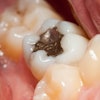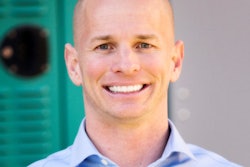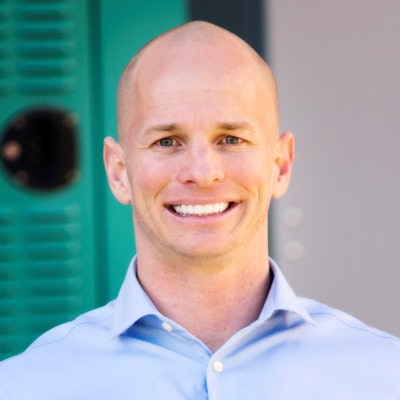
How much does your team affect whether your patients will accept recommended treatment? Do you know? Does it matter? Here's a hint -- it does.
Here's a familiar scenario: Patty Patient calls your office complaining of a toothache. Lucky for her, another patient just canceled, and you have an open slot for Patty to come in later that same day. Once she's in the chair and you have had a chance to examine her, the cause of her pain is clear: She has a cracked tooth. Patty then sheepishly admits to having chewed on some ice while at a party the night before. Some people never learn.
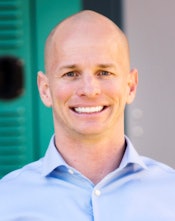 Curtis Marshall.
Curtis Marshall.After sharing treatment options with Patty, you turn her over to Katie, your new dental assistant, and move on to your next patient, assuming you'll be fixing Patty's cracked tooth in the next day or two. However, when reviewing your upcoming schedule with your office manager at the end of the day, you see no sign of Patty on your schedule. What happened?
According to Katie, Patty said funds are a little tight at the moment and that she'll schedule a time for that tooth to be repaired "as soon as possible." This is not what you wanted to hear, of course, but what can you do? The better question is this: What can your team do with patients like Patty to help increase the case acceptance percentage?
We've all heard that our team members play an integral part in patients accepting recommended treatment, but exactly how big is their effect? This is where practice intelligence (PI) plays a critical role. What is PI? Using data integrated from your practice management software and as visualized in a cloud-based dashboard, PI systems give you key insights into all of the vital metrics that affect your dental practice, including case acceptance, cancellation percentage, hygiene reappointment, and dozens more.
Using PI software, let's now look at some recent case acceptance data so we can see the influence that team members have on patients saying "yes" to needed treatment. While the results aren't necessarily shocking, they may surprise you.
In the examples below, we show the case acceptance percentage of two dentists in the same practice. When looking at each dentist's acceptance percentage, we can easily pick the dentist who has the best presenting skills -- or can we?

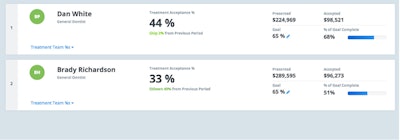
Images courtesy of Curtis Marshall.
Without seeing the team members presenting with the dentist, it's difficult to know for sure if the acceptance rate was affected by the team member presenting with the dentist.
When we look at the team associated with each doctor's cases, we can see the significant effect a hygienist or assistant has on the patient's acceptance of your treatment plan. Practice leaders don't always go this deep when analyzing case acceptance percentages. However, the fact is that team members have a huge effect on a patient's willingness to move forward in completing needed treatment and, because of this, we should make regularly reviewing case acceptance percentages a top priority.
Let's look at treatment acceptance percentage by team member with Dr. Richardson.
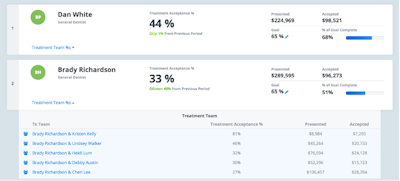
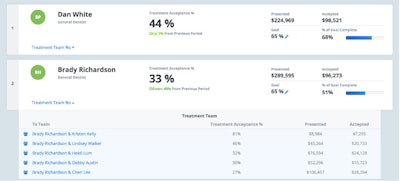
Wow, the hygienist that was with the dentist presenting the most amount of treatment had the lowest acceptance percentage. So, why is there a 19% variance between Dr. Richardson presenting with Cheri versus when he presents with Lindsey?
Do you have variances like this in your practice between treatment coordinators, dental assistants, and your hygienist? If so, do you understand why? If not, let's learn more about this important way of measuring performance in your practice.
After presenting this information to the team and making it easy to monitor daily, the team decided in a staff meeting to discover the difference. Dr. Richardson asked Lindsey, "Lindsey, based on the data, we can see that you are clearly doing something different with the patients after I leave the chair in comparison to everyone else. Can you share with us what you are doing?" He then explained to the team that they weren't doing anything wrong, but that he simply wanted to understand what Lindsey was doing different in order for everyone to obtain the same results. This is a great team approach to looking, discussing, and discovering together.
Lindsey then shared with the team what she did with the patients after the doctor left the operatory. What she was doing wasn't nearly as important as what happened when she explained what she was doing. After hearing what Lindsey was doing, Cheri, who had the lowest acceptance rate when treating patients with Dr. Richardson, let out a huge gasp. He looked at Cheri and said, "What is it, Cheri?" She proceeded to share with the team what she was doing differently, and it was crystal clear that this was the cause of her acceptance rate being lower than her peers. Additionally, every team member expressed some differences from Lindsey.
No one had to tell Cheri what she needed to change in her interactions with patients. The data showed her that something needed to change. Once she had this self-discovery, she took steps to improve and incredible things started to happen. Let's take a look at the very next month.
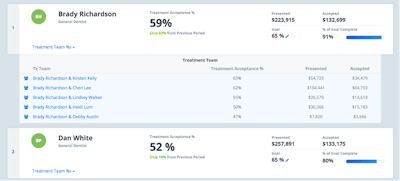
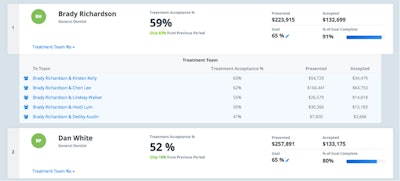
Not only did Cheri experience remarkable improvement in just one month, the entire team improved! This is how powerful data can be when used properly. In case you didn't catch what happened, Dr. Richardson didn't use data as a means of punishment. No one should ever use data this way. Instead, he used the information as a positive influence to coach and encourage, and incredible growth was the result.
Understanding how each team member is performing is half the battle. The other half is acting on the data you have. It doesn't matter whether you create spreadsheets or if you use a practice intelligence solution like Dental Intel -- seeing is believing. Once you and your team members see where they are in relationship to where they want to be, getting there is much easier than not knowing -- and a lot more fun!
Therefore, what?
So, what does this mean for your practice? How can you act upon this information? Begin by implementing a system for tracking the data on a consistent basis. Some practices have done so using forms and spreadsheets to measure performance. Others have discovered the power of "big data," meaning they can now track this and many other key performance indicators (KPIs) through a dashboard, allowing them anytime, anywhere access to their data, as well as the ability to define next actions.
Once you begin accessing this information, the next step is to develop a plan for acting upon the insights you are discovering. For example, if you see that a certain doctor and hygienist have a higher case acceptance percentage when working together, it makes sense whenever possible to schedule them together. Likewise, if you notice that one of your producers may be lagging in case acceptance, perhaps pairing them with one of your top performers so that they can be trained would be a wise move. Without data, however, you are simply guessing.
Finally, stay flexible as you explore what works and what doesn't. Charles Duhigg, author of the bestselling book The Power of Habit, said this about the process of using data to facilitate learning:
When people bring some disturbance into their life, the next essential step is to take a step back a little bit later and say, "OK, so I ran an experiment. What did I learn that worked, and what did I learn that didn't work? How do I take that knowledge and build on it for the next experiment I'm going to run?" When something doesn't work, it's not a failure. It's an experiment that gave you some data. The only way it ever becomes a failure is if you don't learn what you can from it and if you don't make it useful.
Getting started on a new habit is never easy, especially when it involves other people, but waiting until everything is "perfect" before starting is a wait that will never end. Successful practices everywhere are discovering how data can help them to improve patient care, office production, and team culture. When you think about it, improving the case acceptance percentage is really all about taking better care of your patients. That's a change absolutely worth making.
Curtis Marshall is the director of partner operations for Dental Intelligence.
The comments and observations expressed herein do not necessarily reflect the opinions of DrBicuspid.com, nor should they be construed as an endorsement or admonishment of any particular idea, vendor, or organization.
